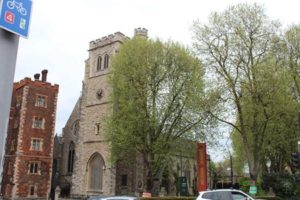
Elizabeth's resting place
Little is known about her early life; however, it is believed she lived and was educated at home until 1508. It is also believed she was well educated and literate, with the poet John Skelton referring to her as a friend of the muses and a patron of the arts. In 1509, Elizabeth went to court and served as a lady-in-waiting to Katherine of Aragon, and the two formed a lifelong friendship. Elizabeth was initially betrothed to her father’s ward, Ralph Neville, 4th Earl of Westmorland. However, Thomas Howard pursued her, and in 1513 they were married, at which point Howard received her dowry of 2000 marks. In her letters, she describes herself as a dutiful wife, and when he became 3rd Duke of Norfolk, their marriage appears to have been one based on mutual affection.
Sadly, the marriage turned sour in 1527 when Norfolk took a mistress, Elizabeth Holland, whom the duchess described as a harlot. However, Elizabeth Holland was no harlot. She became one of the ladies in waiting to Anne Boleyn, something which also antagonised the duchess due to her relationship with Katherine of Aragon. Due to her loyalty to Katherine, Elizabeth Howard was exiled from court for speaking out against Anne Boleyn, and she even refused to attend Anne’s coronation.
By the 1530s, the marriage between Elizabeth and Norfolk had completely deteriorated, with Elizabeth stating that in March 1534, Norfolk had locked her up in a chamber. She was then moved to Hertfordshire, where they lived apart, and she complained of being imprisoned with a small allowance of £200. Norfolk attempted to bribe her into a divorce, promising her the return of her clothes and jewels, but she refused to agree to a divorce. In a series of letters to Thomas Cromwell dated between 1535 and 1539, Elizabeth told Cromwell of her grievances and attempted to get a fair financial arrangement. She wrote of the alleged abuse she had suffered at the hands of household members, who bound her, sat on her until she spat blood and beat her. She also alleged that Norfolk dragged her out of bed by her hair when she was pregnant and wounded her head with his dagger. Norfolk publicly denied these claims, and they damaged her relationship with her son, daughter and brother.
In the late 1540s, Elizabeth reconciled with her brother. However, her marriage remained broken, with Norfolk remaining with his mistress. When Norfolk was accused of treason in 1546, both Elizabeth and his mistress were taken into custody, as both were living in his house at Kenninghall. It may come as no surprise that Elizabeth Howard gave evidence against the duke and benefitted from his arrest, as her valuables were restored to her.
When Mary Tudor ascended the throne in 1553, Elizbeth Howard was finally restored to the court. She accompanied the queen into London on 3rd August and carried her train at her coronation. She died on 30th November 1558 and was buried in Howard Chapel in St Mary’s Church, Lambeth.
by Georgia Whitehead
Georgia has just finished her masters in Classics at the University of Edinburgh. Academically, Georgia is interested in early Christianity, with her master's thesis focusing on "The Male Gaze and Self-Representation in Female Christian Narratives". In addition to her interest in ancient history, she has always been an avid lover of the Tudor era, drawn to the magnificence of the Tudor courts and the larger than life characters. She is particularly interested in The Reformation, Christianity and the shifting sands of ecclesiastical politics in this period and also has a keen interest in the lives of Tudor women. It is Georgia's ambition to become a writer, perhaps publishing her own Tudor novel one day.
Georgia also runs a history blog and instagram page called Historia Mundis.
Sources
- D. M. Head, The ebbs and flows of fortune: the life of Thomas Howard, third duke of Norfolk (1995)
- B. J. Harris, ‘Marriage sixteenth century style: Elizabeth Stafford and the third duke of Norfolk’, Journal of Social History, 15/2 (1981), 371–8.
- R. M. Warnicke, The rise and fall of Anne Boleyn (1989)


You don’t read much about domestic abuse by either sex in this age, not really much at all until the first academic studies revealed the endemic abuse during the Georgian and Victorian periods. I recall reading an article on the abuse by Norfolk on his wife and his counter claims of abuse by Elizabeth. Looking through the lens of 500 years the truth is very difficult to discover but it did put a spotlight on the possibility of marital abuse behind closed doors in the Tudor era. Elizabeth Howard Stafford was obviously a very strong lady and took no nonsense from her husband.
Elizabeth Holland may not have been a wh*re, but she was an adultress and I can imagine the Duchess was outraged. Men do pretty stupid things, but this was a really daft thing to do, wreck an otherwise decent marriage. I would think that was the root of any abuse and yes, it was probably brutal and just as bad on both sides. Even today there are couples who really do get physical with each other and women do abuse men. A very early study by Liverpool John Moores University showed that 16% of all reported abuse cases are actually men being abused by female partners. As men are less likely to report than women, the figures are going to be higher. Its hard enough to get women to report and prosecute domestic violence, let alone men, even harder if the attacker is male, as in same sex relationships. At the time the researcher was ridiculed when highlighting the issues but now we have seen by more research that this is a real issue. What Norfolk did was dreadful, hitting his pregnant wife is disgusting, a man hitting a woman, disgusting, but I am more inclined to accept the possibility at least that Elizabeth gave as good as she got.
Something else which strikes me is that the couple eventually did separate and lived fairly independent lives. They also both lived long lives for the times, seeing four Monarchs.